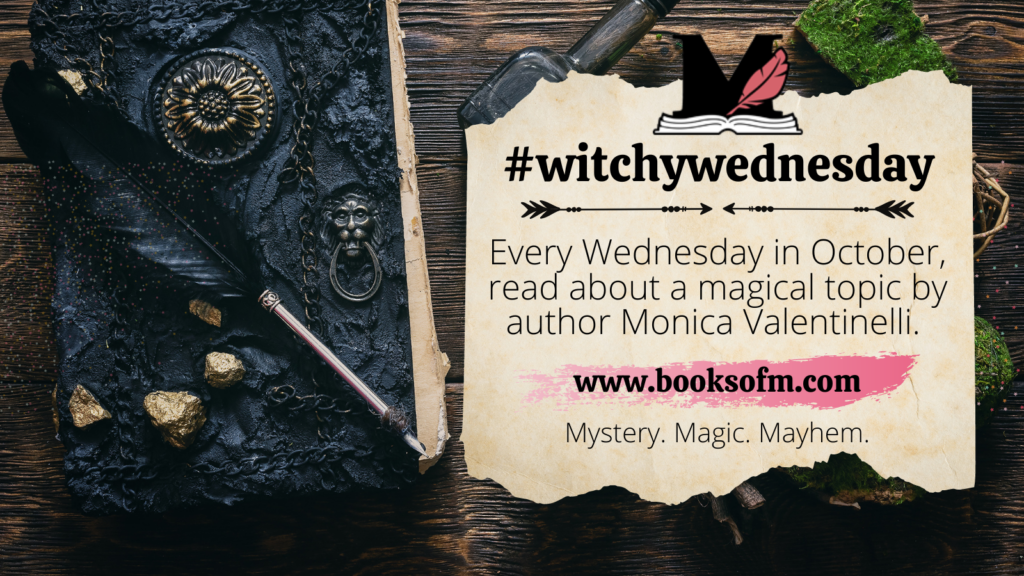Poisoned Treats and Lures for Witchy Wednesday
Posted on October 16, 2024 by Monica Valentinelli
When you conjure a witch in your mind? What do they look like? Are you picturing an older woman with deep wrinkles and gnarled hands? What’s their demeanor? Cruel, mischievous, or kind?
Depictions of witches around Halloween are influenced by folk tales, like the German “Snow White” fairy tale collected and published in 1812 by the Grimms Brothers, as well as cinematic representations, like rendering evil witches with green skin thanks to The Wizard of Oz (1939) in full technicolor.
Most witches, especially the kind that fly on brooms, have been known to lure children to gobble them up or, like the witches in Hocus Pocus franchise, to revive their youthful appearances.
The idea that old women in the woods will lure children to eat them is, in many ways, evidence of an urban legend that emerged in Europe during famines, wars, and harsh winters. The warnings serve multiple purposes. Don’t go into the woods by yourself, kids. Don’t talk to strange, old women if you do. And don’t accept treats or bribes from them.
Old women in the woods did exist, but not for nefarious reasons. Economics was a huge factor. Up until 1870, for example, English widows did not inherit or have access to the household’s wealth after their spouse’s passing. So, what’s a widow to do if she’s no longer considered “useful,” by society’s standards? Where is she supposed to live if her family won’t or can’t take her in? Well, there’s always a cabin in the woods.
An untamed, wild forest holds a lot of power in stories, and is present in allegory and metaphor. Take a moment and replace “woods” with “wilds” to understand how those warnings change. Don’t go into the wilds. Don’t leave your family, your community, your society behind to wander alone in uncharted territories. Don’t be a pioneer or a brave explorer. Here, you are safe.
The treats that witches present to children are rife with metaphor and, sometimes, lost meanings. Sometimes, these poisoned treats are taken whole cloth from an urban legend; stories rooted in tragedy and, all too often, murder. Sometimes, it’s just a prank played to teach kids a lesson. Or, sometimes, the treats aren’t a lure at all, like the Italian story of La Befana, but a promised reward for good behavior.
One of the most iconic treats that a witch gives a child is a poisoned apple. True or false? Well, it turns out apple seeds–which kids would eat if food was scarce or they’re taught to leave no scraps behind–have trace amounts of cynanide in them. And, if kids eat enough seeds (amounts vary by body mass/weight) they could poison themselves. The myth of the poisoned apple, most famously in Snow White, also emerges in the wake of a misunderstanding. Except, the poisoned apple wasn’t plucked from a tree at all. In the late 18th century, the “poisoned apple” was synonymous with the tomato.
Food poisoning that resulted in death was much, much more common up until the 20th century, because the chemicals that naturally occur within foods were not well understood or documented. In the late 1700s, some aristocrats died after eating tomatoes–because the acid had interacted with the lead in their dinner plates. But, because people didn’t understand that a deadly chemical reaction had ccurred, the tomato was blamed and a widespread fear of the poison apple emerged throughout Europe. Some botanists had even reclassified the tomato as a poisonous substance–a member of the nightshade family! This misunderstanding was prominent when the Snow White fairy tale was collected and published; the poisoned apple drew on the fears people could relate to.
Today, the poisoned apple is not only a witch’s gift, it’s also common in warnings to inspect Halloween candy and gifts from trick-or-treating. This, too, has some truth to it. If you grew up in the 1970s or 80s, you were probably warned from eating apples after Trick or Treating–unless you checked them from razor blades. You were probably told to inspect your candy for wrappers, because it could be poisoned. Like the apple, there is some truth to this myth: a dentist named William V Shyne played a prank on kids and gave them laxatives (aloe pills) instead of candy.
Aloe pills are a type of laxative that, in small quantities, aren’t harmful. Similar to apples, however, the effect of that laxative will vary on the kid’s mass/weight. And, kids being kids? The kind of trick-or-treaters who always trade candy or want more? Well, that dentist’s prank escalated to cruelty when some kids wound up with dozens of pills. Ever since then, the phrase “don’t take candy from a stranger” has a whole ‘nother meaning.
Unfortunately, there are other cases that are far more tragic–parents murdering their children by contaminating their treats and trying to cover up the crime. There may not be a cause to panic, but it seems like it’s always a good idea to inspect your trick-or-treat candy, regardless, with or without witches.
I hoped you enjoyed this edition of #WitchyWednesday! If you dig this series, feel free to contribute to my coffee fund. Have a topic you’d like me to cover? Suggest your favorite witchy subject in the comments.
Resources for Further Reading
boingboing.net/2014/10/29/why-are-witches-green.html
inverse.com/science/poison-apple-myth-confirmed-food-science
italiarail.com/culture/legend-la-befana
en.wikipedia.org/wiki/Married_Women%27s_Property_Act_1870
deannamolnar.wordpress.com/2019/11/12/witches-and-trees-art-environment/
smithsonianmag.com/arts-culture/why-the-tomato-was-feared-in-europe-for-more-than-200-years-863735/
psychologytoday.com/us/blog/the-human-equation/201510/the-men-who-murdered-halloween
cbc.ca/news/health/halloween-candy-tampering-urban-legend-truth-1.5341734
Missed my other articles? Check out the Origins of Tarot and American Colonial Witches for #WitchyWednesday in October!


